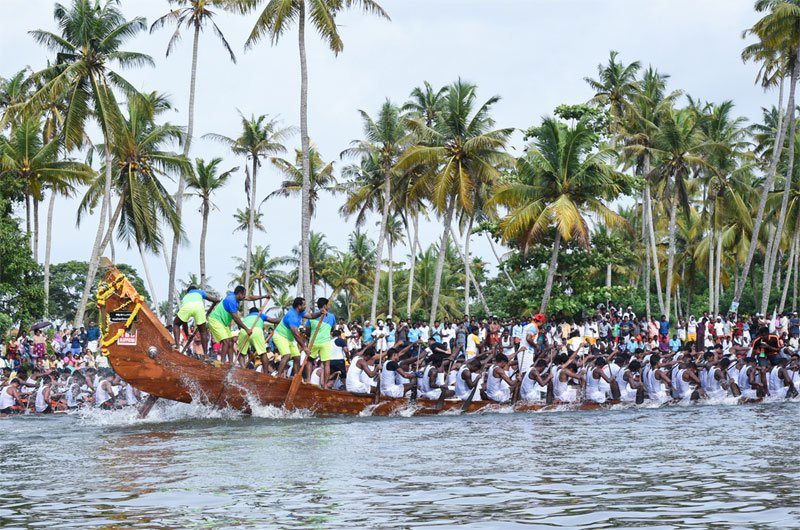
Festivals of Kerala: A Kaleidoscope of Culture and Tradition
Kerala’s festivals are a testament to its rich cultural diversity, deep-rooted traditions, and vibrant community life. Each festival, with its unique rituals and celebrations, offers a glimpse into the colorful and dynamic heritage of this beautiful state.
1. Onam
Time of Festival
- Celebrated in August or September, marking the beginning of the Malayalam calendar year (Chingam).
Specialty of the Festival
- Commemorates the homecoming of the legendary King Mahabali.
- Features grand feasts known as Onasadya, intricate floral decorations (Pookalam), and traditional dance forms like Thiruvathira.
- Includes Vallam Kali (boat races), Pulikali (tiger dance), and various cultural programs.
Locality of the Festival
- Celebrated across Kerala, in both urban and rural areas.
Nature of the Festival
- Cultural and religious.
- Emphasis on community bonding, prosperity, and cultural heritage.
- Features feasts, dances, boat races, and communal activities.
2. Vishu
Time of Festival
- Celebrated in April, marking the Malayalam New Year.
Specialty of the Festival
- The day begins with Vishukkani, an auspicious sight arranged with items like rice, fruits, and flowers.
- Traditional Vishu Sadhya (feast) and Vishukkaineetam (gift giving) are key components.
- Fireworks and new clothes are part of the celebrations.
Locality of the Festival
- Celebrated across Kerala, with special fervor in central and northern regions.
Nature of the Festival
- Cultural and religious.
- Emphasis on prosperity, new beginnings, and family bonding.
- Features feasts, rituals, and community gatherings.
3. Thrissur Pooram
Time of Festival
- Celebrated in April or May.
Specialty of the Festival
- Known for its grand elephant processions, traditional drum ensembles (Panchavadyam), and fireworks.
- Features the Kudamattom, a colorful display of parasols atop elephants.
- The Pooram is a competition between two temples, Paramekkavu and Thiruvambadi.
Locality of the Festival
- Celebrated in Thrissur, particularly at the Vadakkunnathan Temple.
Nature of the Festival
- Cultural and religious.
- Emphasis on community participation, tradition, and grandeur.
- Features processions, musical performances, and fireworks.
4. Kerala Boat Races
Time of Festival
- Held during the monsoon season, from July to September.
Specialty of the Festival
- Vallam Kali (boat races) feature traditional snake boats (Chundan Vallams) and are fiercely competitive.
- The most famous race is the Nehru Trophy Boat Race held in Alappuzha.
- Includes rhythmic rowing to the tune of traditional boat songs (Vanchipattu).
Locality of the Festival
- Predominantly celebrated in the backwaters of Alappuzha, Kottayam, and Kollam.
Nature of the Festival
- Cultural and traditional.
- Emphasis on teamwork, tradition, and regional pride.
- Features boat races, community gatherings, and festive celebrations.
5. Attukal Pongala
Time of Festival
- Celebrated in February or March.
Specialty of the Festival
- Known as the largest gathering of women for a religious activity, recognized by the Guinness World Records.
- Women cook Pongala, a sweet dish made of rice, jaggery, and coconut, as an offering to the goddess Attukal Amma.
- The festival is a symbol of devotion and community spirit among women.
Locality of the Festival
- Celebrated at the Attukal Bhagavathy Temple in Thiruvananthapuram.
Nature of the Festival
- Religious and cultural.
- Emphasis on devotion, community participation, and women’s empowerment.
- Features mass cooking, prayers, and communal harmony.
6. Theyyam
Time of Festival
- Celebrated from October to May.
Specialty of the Festival
- A ritualistic dance form that involves elaborate costumes, face painting, and divine impersonations.
- Theyyam performers are believed to become possessed by the deity they represent.
- Rituals include fire-walking, trance performances, and intricate dances.
Locality of the Festival
- Predominantly celebrated in the northern districts of Kannur and Kasaragod.
Nature of the Festival
- Religious and cultural.
- Emphasis on tradition, spirituality, and divine worship.
- Features ritualistic performances, traditional music, and community gatherings.
7. Makaravilakku
Time of Festival
- Celebrated in January.
Specialty of the Festival
- Marks the climax of the Sabarimala pilgrimage.
- Devotees witness the Makarajyoti (celestial light) and Makaravilakku (ritualistic light) on the hills of Sabarimala.
- Rituals include the sacred bath in the Pampa river and offering prayers at the Ayyappa Temple.
Locality of the Festival
- Celebrated at the Sabarimala Temple in the Pathanamthitta district.
Nature of the Festival
- Religious and spiritual.
- Emphasis on devotion, penance, and spirituality.
- Features pilgrimages, rituals, and communal prayers.
8. Christmas and New Year
Time of Festival
- Celebrated in December and January.
Specialty of the Festival
- Christmas includes midnight masses, carol singing, and festive feasts.
- New Year is celebrated with fireworks, parties, and cultural events.
- Churches and homes are decorated with lights, stars, and nativity scenes.
Locality of the Festival
- Celebrated across Kerala, with significant celebrations in regions with Christian communities like Kochi, Kottayam, and Thiruvananthapuram.
Nature of the Festival
- Cultural and religious.
- Emphasis on joy, renewal, and family bonding.
- Features masses, feasts, decorations, and community celebrations.
9. Eid-ul-Fitr and Eid-ul-Adha
Time of Festival
- Eid-ul-Fitr is celebrated at the end of Ramadan, while Eid-ul-Adha is celebrated about two months later.
Specialty of the Festival
- Eid-ul-Fitr involves breaking the fast with communal prayers, feasts, and charity.
- Eid-ul-Adha includes the ritual sacrifice of animals, prayers, and distribution of meat.
- Both festivals emphasize community bonding and charitable acts.
Locality of the Festival
- Celebrated across Kerala, with significant celebrations in regions with Muslim communities like Malappuram, Kozhikode, and Kasaragod.
Nature of the Festival
- Religious and cultural.
- Emphasis on faith, charity, and community spirit.
- Features prayers, feasts, and charitable activities.
